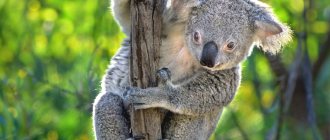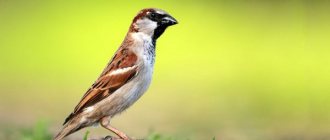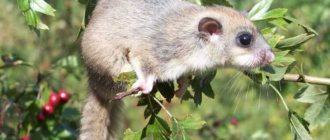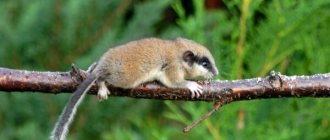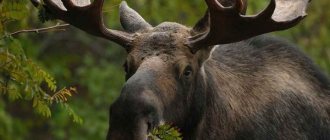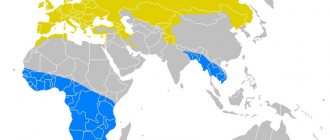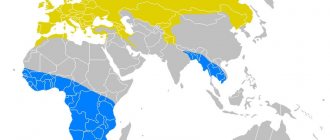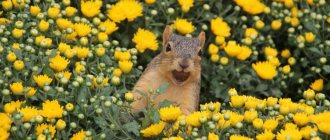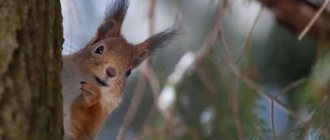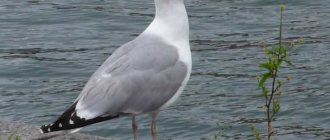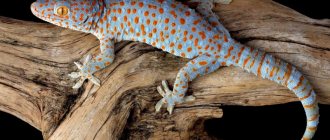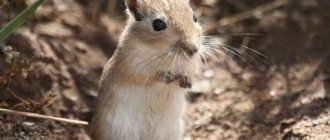- Wild animals
- >>
- Mammals
The cute quokka has become incredibly popular thanks to his charming, good-natured smile and always positive attitude. The Internet is filled with photographs of this hilarious and cute animal, which is very sociable and often poses in them with two-legged animals. Let's try to find out more about the life activity of this amazing marsupial by studying its external features of habit, food preferences and places of permanent deployment.
Quokka - description
Quokka is the only representative of its genus in the kangaroo family, so it looks like a fat kangaroo. The size of the animal is small - most often they do not grow larger than cats. The height of an adult is 47-50 cm, and the weight is up to 5 kg.
The large family of kangaroos includes many species of animals that are radically different from each other. Quokkas have a very short tail - 35 cm, used as a support. Kangaroos have a tail for a reason - it is an opportunity to protect themselves from predatory animals, but quokkas are not able to do this.
quokka
The small jumping animal is completely covered with thick medium fur of a red or grayish-red color.
Without hair, only the tail and tips of the legs remain on the quokka's body - in these areas the skin is dark, almost black. Powerful hind legs enable the animal to move by jumping at speeds of up to 50 km/h. The front legs are small and weak, they are needed so that the animal can eat. The quokka lifts and holds food with them. The animal's diet includes grass, plant shoots, fruits and leaves. Interesting fact : quokkas are very curious animals, they are interested in communicating with people.
However, despite their friendly appearance, they are not always worth petting. Quokkas can accidentally jam their jaws into your hand, and they bite small children every year. Animals, of course, will not cause irreparable harm, but children will be scared, and bruises will remain on the skin. Quokkas are born without hair, gradually acquiring thick gray-brown fur. The ears are round, located close to each other. Thanks to them, the animal’s appearance is slightly comical and cute. Together with a constant smile, a feeling of good nature is created. Small button eyes are located near the bridge of the nose. The animal has no fangs; leaves and stems are bitten off due to the impact of powerful jaws. They live in large families of up to 50 individuals.
Baby quokka
Diet
A quokka eats a leaf.
The quokka animal, like other representatives of the wallaby, is a full-fledged vegetarian. The daily diet includes nearby grasses that grow in the short-tailed kangaroo's natural refuge.
Also, eat berries, fruits and leaves in the diet if these products are in abundance.
Kinds
A unique animal, the only representative of its kind. The closest relative is the wallaby, otherwise called the dwarf kangaroo; they are in an intermediate stage of development between ruminants and non-ruminants.
Wallaby
Rottnest Island, which is located 18 km from the western coast of Australia, is named so precisely because of these cute animals. Dutch sailors who discovered the island in the 18th century found hordes of amazing smiling animals there, a bit like rats because of their tails. The name Rottnest, which stuck in those years, is otherwise translated as “rat’s nest.”
Interesting: Why does the boomerang come back? Explanation, drawings, photos and videos
Quokka habitat
Quokkas historically ranged throughout Australia, but their population declined rapidly during human settlement on the mainland. The reason for this is not poaching or industry, but animals brought from the continents that hunted marsupials.
Quokka habitat
Quokkas are defenseless creatures, they cannot fend for themselves in front of predators, and in its habitat there have never been any predatory animals, so quokkas are absolutely not adapted in this regard. The main enemies of quokkas at the moment are ordinary domestic cats and dogs brought by people.
Interesting fact : on Rottnest Island you should handle quokkas carefully; you should never break the rules - you will be issued a large fine. The least fine is only for feeding human food - 300 US dollars, if you cause injury - 50 thousand US dollars, and for murder you face a real prison sentence of up to five years.
Now the animals live on small islands around Australia - in Balda, Rottnest and Penguin. Sometimes they can be found on the continent in Albany. Quokkas prefer to live in dry grassy fields where there are dense bushes.
Quokka - lifestyle and habitat
Quokkas, similar in appearance to an otter, are relatives of kangaroos, run fast and jump well, reaching speeds of up to 50 km/h.
If living conditions deteriorate sharply, then quokkas begin to wander, moving to places atypical for them. In dry times, they move to swampy areas where there is sufficient water and humidity for life. Quokkas are nocturnal animals, they see well in the dark, they have a keen sense of smell and hearing. During the day, animals prefer to hide in the bushes without attracting attention.
Quokkas also have peculiarities in the field of reproduction. After mating, quokkas produce two embryos at once, one of which develops rapidly, and the second is in a state of pause. The animal is a marsupial, so the offspring are born in a special pocket on the animal’s belly.
Quokka with baby
The first baby after birth stays in this pouch for a long time. At the same moment, the second embryo begins to develop, which is born only at the moment its predecessor leaves the mother’s pouch. Therefore, a female becomes pregnant twice after meeting one male.
Interesting fact : Settonix also live in Australian zoos in the cities of Petra, Adelaide and Sydney. In open enclosures, animals often hide from people, so they are kept only in glass-enclosed enclosures with a ban on contact with zoo visitors.
Lifestyle
Directly on the Australian mainland, short-tailed kangaroos live in small flocks of up to 20 individuals. And on the islands there are 150 individuals. Although quokkas live in colonies, they are not really very social.
Quokka looking cutely at the camera
For example, in the social hierarchy of males the rule “he who is bigger is more important” works. But females generally try not to come into contact with each other.
Setonix brachyurus searches for food at night, but likes to rest during the day, escaping the famous Australian heat in the Agonis bushes. Quokkas live in one place for a long time, but can change location due to changes in the environment. The cause may be predators or environmental problems.
Quokka enemies
Quokkas are completely defenseless against predators; they have neither powerful tails nor fangs and claws. They always live in large families, headed by a dominant male who controls the external environment around the family’s temporary shelters. Quokkas are kind and absolutely non-aggressive. They will not conflict with other animals that enter their territory.
Interesting: The largest seasonally dry rivers - list, names, when they dry up, description and photo
The animals are trusting, love people and make contact easily. Quokkas were listed in the Red Book in order to preserve their population. There really aren’t that many of them left – in Australia there are only 4 thousand quokkas living in families of 50 individuals. For causing harm to animals, poachers are subject to large fines and even prison sentences.
Interesting fact : the dingo dog, which appeared on the islands 3.5 thousand years ago, as well as foxes, cats and dogs brought from other continents, greatly reduced the population of animals. The only place predators did not penetrate was Rottnest, where the animal population remained unchanged until the arrival of humans, who introduced many viruses and infections.
Features of character and lifestyle
Photo: Quokka from the Red Book
Quokkas are active at night, when the danger posed by various predators is minimal. This is a harmless animal that is unable to resist insidious and larger opponents. Quokkas have been seen building green tunnels consisting of grasses and shrubs; they serve as an animal barrier against ill-wishers; moving through such a tunnel is much safer, and the chances of escaping from a pursuer increase.
Quokkas, like all kangaroos, move using rapid jumps. Despite the fact that the animals are very friendly, before the wedding season they prefer a solitary existence. Quokka loves holes and all kinds of shelters; in hot weather, she can dig a hole in the grass and lie in it, chilling in the shade and waiting for it to get dark to start her late meal. In search of a snack, the quokka usually moves along already familiar, well-trodden paths. In moments of fear or anticipation of some threat, the marsupial loudly knocks on the ground with its impressive hind limbs.
If we talk about the character of these unusual short-tailed kangaroos, then they can be called peace-loving, completely harmless and the cutest creatures. One has only to look at their happy faces, and the mood immediately lifts. It should be noted that animals do not shy away from people at all, they do not feel threatened by them and often approach a person themselves out of curiosity.
Interesting fact: Quokka is very sociable and loves to be the center of attention, so tourists trying to capture it in a photo do not irritate the animal at all, but, on the contrary, bring pleasure. The animal is photographed with great interest together with people and the pictures turn out simply excellent.
Quokka and keeping at home
Quokkas are even found in homes. However, this is a wild animal and it will not fully adapt to living conditions with humans . Animals love warmth, they need to walk, so quokkas will not take root in apartments. In addition, it is necessary to ensure constant access to fresh grass and shoots of young trees. It is prohibited to export quokkas outside of Australia, so only local residents can have them. Life expectancy in other climatic conditions is reduced by half ; there is no point in torturing an animal. The animals are family animals, so they will not be able to live completely alone all year round, hormonal disruptions will occur, the quokka will begin to wither and die.
Peculiarities of breeding of the short-tailed kangaroo
Also, these animals are interested in the characteristics of reproduction. The female brings one cub (it is born naked, and even deaf - with a plug in its ears). And although the quokka is an almost ideal mother, and there is always a warm pouch on the belly for the baby, sometimes the death of the offspring occurs. In this case, the female gives birth to another baby, but for this she does not need to mate with the male again. Initially, two embryos develop in her stomach, and if she begins to feed milk, then after a while the second embryo dies. But if lactation does not occur, then the second embryo begins to grow and develop. Such a miracle is extremely rare in nature.
Nutrition
Diet of quokkas
Quokkas live in hard-leaved forests, feeding on young shoots of eucalyptus, a variety of flowers, many roots, seeds and grass. All these plants have hard fibers, which the quokka gradually grinds with its jaws, this is a long process. Quokkas make funny sounds. The food is swallowed, spat out, and chewed like chewing gum. At the end of the meal, the animal relaxes its jaw muscles and smiles radiantly at everyone.
The animals obtain food at night, moving among the grass. Quokkas can climb to a height of up to 1.5 meters, collecting young shoots of trees. The gastrointestinal tract bacteria of quokkas resemble those of sheep. During drought, animals migrate to other lands for food and water. If the drought does not last so long, then the animal can get water from succulents with juicy pulp. The quokka's closest relatives, the wallaby, are much less adapted to high temperatures; quokkas can thrive in temperatures up to 44 degrees Celsius.
Interesting: Why is Greenland an island?
Reproduction and lifespan
Despite living in families, quokkas love privacy. Communication between males and females occurs only during the mating season. The rest of the time everyone is on their own. Control over the family is exercised by the dominant male, who protects the shelters from incursions by other animals.
The dominant male is the father of most of the cubs of the family. The rest of the males get everyone who remains. There are no battles for power among animals; when the leader gets old, he transfers his powers to the strongest.
A female can become pregnant in the first 28 days immediately after mating begins; after the same period, the first baby is born, which matures for five months in the mother’s pouch; after it matures, the second is born. It waits another 28 days to be born after the first one is released, and then goes into the mother’s pouch.
If there is little food, then the second baby may not be born at all. Quokkas live a short lifespan - up to 10 years, so sexual maturity occurs quickly - females do not even have a year of life.
Childbearing
Female short-tailed kangaroos are capable of producing one offspring per season. The continent is characterized by breeding twice a year due to the risk of losing offspring.
Pregnancy lasts one month. Immediately after birth, the baby is moved to the mother's pouch, where it remains for six months and continues to develop physically.
Quokka with baby
It is worth noting that immediately after giving birth, the quokka mother mates again and activates “embryonic diapause” - this is a protective mechanism for childbirth. The embryo remains in a state of diapause for about 5 months. Photo of a quokka with a baby below.
Another embryo is needed to restore offspring in the event of the loss of the first baby. If everything is fine with the quokka baby, then the embryo disintegrates. If the baby dies, the embryo is implanted and begins to develop in the womb of the quokka mother.
Little quokka
After being separated from the pouch, the cub begins to explore the world around it. By nine to twelve months, the young quokka reaches sexual maturity. From this moment on, the baby can be considered an adult.
Why does the quokka smile all the time?
Quokkas are famous for their far from funny lifestyle and good nature; small mammals, listed in the Red Book, constantly smile. This signature smile has made the animals famous all over the world. It seems that the animal constantly admires everything that happens around, without losing optimism. Millions of tourists come to Australia every year to buy or take pictures with a quokka.
The smile of an animal is nothing more than the result of relaxation of the jaw muscles after chewing food for a long time. Animals feed on hard eucalyptus leaves, chewing them like cud. You cannot feed animals with your own food, as this can result in a heavy fine.
If you find an error, please select a piece of text and press Ctrl+Enter.
Smiling quokka animal in the Red Book
Quokka in the forest
The International Union for Conservation of Nature has listed short-tailed kangaroos as endangered. The quokka is listed as “vulnerable to extinction in the environment.” Therefore, keeping a quokka at home is punishable as a criminal offense.
The IUCN estimates there are between 7,500 and 15,000 adult short-tailed kangaroos worldwide.
